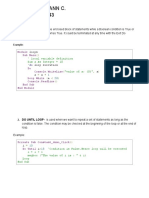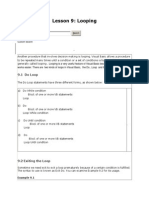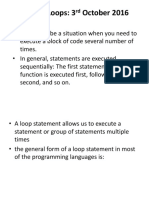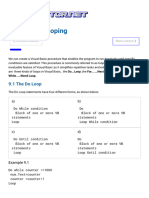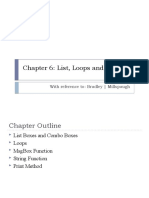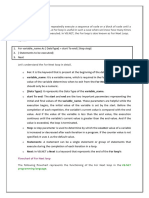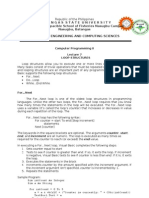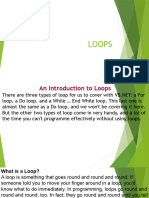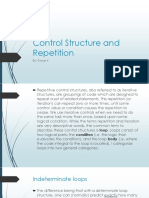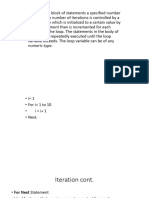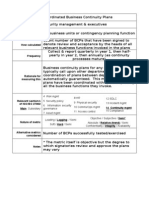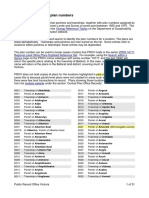Republic of the Philippines
OCCIDENTAL MINDORO STATE COLLEGE
Labangan, San Jose, Occidental Mindoro
website: www.omsc.edu.ph email address: omsc_9747@yahoo.com
Tele/Fax: (043) 457-0231 CERTIFIED TO ISO 9001:2015
CERT. NO.: 50500643 QM15
Learning Module in
Object-Oriented Programming
Compiled by:
MARICRIS M. USITA, Ed.D
AILA CHESKA V. FAJARDO
NICKO B. CABULING
The compiler does not own any of the contents of this learning module. Due credits and
acknowledgment are given to the authors, internet sources, and researchers listed on the
reference page. Such sources are reserved to further explain concepts and cannot be credited
to the compiler and the school. All diagrams, charts, and images are used for educational
purposes only. The sole objective of this instructional material is to facilitate independent
learning and not for monetary gains because this is NOT FOR SALE.
2020 Edition
� LISTS AND LOOPS
6
TOPICS
1. The For Next Loop
2. The do Loop
3. The while Loop
LEARNING OUTCOMES
At the end of the lesson, students should be able to:
1. compare and contrast the different type of loops;
2. design a program using the for next, do, and while loop; and
3. create a functional program using for next, do, and while loop.
TOPIC 1: FOR NEXT LOOP
A procedure in a computer program that repeatedly runs until meeting a certain condition is
called looping. A loop can go on repetitively as long as the processor and memory could support
it. For example, a program that adds a series of numbers until the sum exceeds a certain value or
a program that prompts the user to enter data repeatedly until he or she enters the word ‘Finish’.
The three methods of Looping, the For…..Next loop, the Do loop, and the While…..End
While loop. All methods produce the same repetitive effects.
The most common looping method in VB 2013 is the For....Next loop. The structure of a
For...Next loop is as shown below:
For counter=startNumber to endNumber Step increment
One or more statements
Next
To exit a For..Next Loop, you can place the Exit For statement within the loop; it is normally
used together with the If….Then statement. For its application, you can refer to example 1.
Example 1
Dim counter as Integer Possible output:
For counter= 1 to 10
ListBox1.Items.Add (counter) * The program will enter numbers 1
Next to 10 into the list box.
Example 2 Possible output:
Dim counter, sum As Integer
For counter=1 to 100 step 10 The programme will calculate the
sum+=counter sum of the numbers as follows:
ListBox1.Items.Add (sum) sum=0+10+20+30+40+…….
Next
Example 3 Possible output:
Dim counter, sum As Integer
sum = 1000 *Notice that increment can be
negative. The program will
For counter = 100 To 5 Step -5
compute the subtraction as follow:
sum – = counter
1000-100-95-90-……….
ListBox1.Items.Add(sum)
Next
41
�Example 4
Possible output:
Dim n as Integer
For n=1 to 10 The process will stop when n is
If n>6 then greater than 6.
Exit For
End If
Else
ListBox1.Items.Add ( n)
Next
End If
Next
TOPIC 2: DO LOOP
The Do Loop structures are
a)
Do While condition
Block of one or more statements
Loop
b)
Do
Block of one or more statements
Loop While condition
c)
Do Until condition
Block of one or more statements
Loop
d)
Do
Block of one or more statements
Loop Until condition
Sometimes we need an exit to exit a loop prematurely because a certain condition is fulfilled. The
syntax to use is Exit Do. Let's examine the following examples:
Example 5
Possible output:
Do while counter <=1000
TextBox1.Text=counter * The above example will keep on
counter +=1 adding until counter >1000.
Loop
The above example can be rewritten as
Do
TextBox1.Text=counter
counter+=1
Loop until counter>1000
Example 6
Private Sub Button1_Click(ByVal sender As System.Object, ByVal e As System.EventArgs)
Handles Button1.Click
Dim sum, n As Integer
ListBox1.Items.Add(“n” & vbTab & “Sum”)
ListBox1.Items.Add(“———————-”)
42
� Do
n += 1
sum += n
ListBox1.Items.Add(n & vbTab & sum)
If n = 100 Then
Exit Do
End If
Loop
End Sub
* The loop in the above example can be replaced by
the following loop:
Do Until n = 10
n += 1
sum += n
ListBox1.Items.Add(n & vbTab & sum)
Loop
TOPIC 3: WHILE LOOP
The structure of a While….End While Loop is very similar to the Do Loop. It takes the following
form:
While conditions
Visual Basic 2013 statements
End While
Example 7
Private Sub Button1_Click(sender As Object, e As
EventArgs) Handles Button1.Click
Dim sum, n As Integer
ListBox1.Items.Add("n" & vbTab & "sum")
ListBox1.Items.Add("———————-")
While n <>10
n += 1
sum += n
ListBox1.Items.Add(n & vbTab & sum)
End While
End Sub
Example 8
Private Sub Button1_Click(sender As Object, e As
EventArgs) Handles Button1.Click
Dim Counter As Integer Possible output:
Counter = 1
While (Counter < 10) * The above example will keep on
MsgBox("The Counter is now " & Counter) adding until counter reaches 10.
Counter = Counter + 1
End While
End Sub
43








